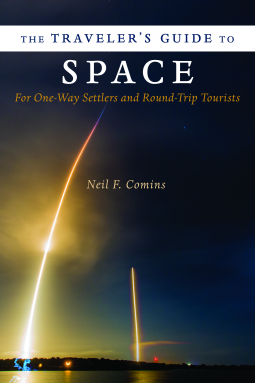Travel and tourism is a huge industry, with no shortage of travel books for all types of destinations available. But even the seasoned wanderluster has yet to encounter a travel book for space. Space tourism will not be a reality for the masses for many years yet (only 7 paying tourists have been able to afford it so far), but you can still dream. In fact, planning for the myriad of physical and mental difficulties is essential, from weightlessness to claustrophobia to loss of bone density, and if you feel a thrill of excitement at the thought of seeing the Earth from a profoundly different perspective, The Traveler’s Guide to Space will indulge you a trip, if only vicariously.
Astronomer Neil F. Comins provides an overview of space exploration in an easy and approachable format that mirrors typical guides from The Lonely Planet or Frommer’s, including insights about specific destinations and activities, space sickness, tips for souvenirs, and a frame of reference. But whereas most travel books include blurbs on history, politics, and culture, Comins presents some scientific background on radiation, planetary orbits, and the necessary business of maintaining human life in an inhospitable environment.
Imagine the possibilities! From quick suborbital flights, to space stations, asteroids, comets, the Moon, and even Mars, there is so much to see and do! And on the way to your final destination, learn how to stave off boredom (and depression, homesickness, impulsiveness, and anger towards with fellow passengers because they are encroaching on your telephone booth-sized area of personal space) with classes, sports, photography, eating, drinking, using the toilet, and sex, all of which you will need to relearn while in microgravity.
Recommended for space fans with active imaginations!
Also, here are some lovely science tidbits to whet your appetite for space—
- Contrary to many scifi movies, an explosion in space would be very quiet.
- Outside of the Earth’s atmosphere, stars do not twinkle.
- You will get very dirty on the Moon; the dust is electrically charged and sticks to everything.
- On Mars, sunrises and sunsets are blue, and the daytime sky is orange-yellow.
